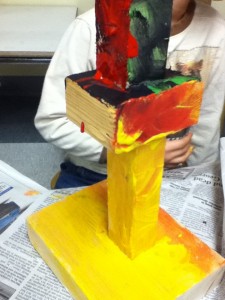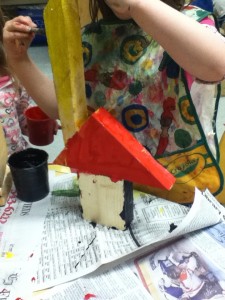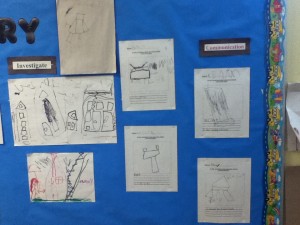In continuation with our beautiful stuff project, the children used real wood piece to create home, buildings, bridges and other various structures. The children created, draw their designs, labelled some parts, glued and painted their designs. It was a great and fun experience.




 This student independently drew a picture of his neighbourhood when we were writing in our journals. He carefully selected shapes that are parts of a building, told me about the buildings-some stores and houses and added stairs that go to the bed on the top floor (blueprints show stairs!).
This student independently drew a picture of his neighbourhood when we were writing in our journals. He carefully selected shapes that are parts of a building, told me about the buildings-some stores and houses and added stairs that go to the bed on the top floor (blueprints show stairs!).
Often we found that we needed to stimulate some conversation within the centres and to change things up from the typical blocks in our building centre, we brought in recylced materials. We collected a variety of boxes, toilet paper rolls, and added some tape, crayons, and scissors. We got some logs from the forest about 8 pieces that they would be able to carry easily. We bought some reflective vests, PVC piping from the plumbing section of the hardware store and pylons from the gym.
The look on their faces the very next day was priceless! As the day progressed they creativity was truly coming to live and the oral conversations were great! Later on we added some inspirational pictures and books of firefighters, buildings, and different modes of transportation. This also lead us into creating moving vehicles in our art centre. We created modes of transportation using recycled materials, straws, dowels, spools, etc.
Play is critical to learning. Children learn best when they can play, explore their world and interact and talk with adults and peers. From personal experience, I have seen some students disengage with mindless tasks quickly and you may even see some different behaviours.
Centres are an excellent way to share the oral language experience, see their personalities and creativity, and to collect great assessment information. I often carry around a clipboard with both blank paper, and paper divided into squares where I can record a child’s name. You just never know what is going to happen as you share…..
When planning a centre think of these:
- What is my big ideas, my goal that I am trying to achieve?
- What are my open-ended questions (2 or 3) so I can begin the conversation? Oral language assessing?
- Do I have enough materials that they can explore?
- Pause and Reflect on what you see and hear from your students?
Listeded below are some links within this site that discuss the importance of play.
Colouring sheets to materials that will explore their creativity……..
Research on play vs worksheets http://ultimateblockparty.ca/home/wp-content/uploads/2011/03/Play-or-worksheets.pdf
Playing is learning http://ultimateblockparty.ca/home/wp-content/uploads/2011/03/Planning-for-Play.pdf
The importance of play http://earlylearningcentral.ca/wp-content/uploads/2011/08/importanceplay.pdf
Now that the you have had the opportunity to meet your students over the last little while, you can reflect on your daily schedule. Thinking it Through has a plan for both full and half days. http://earlylearningcentral.ca/?page_id=1218 . Some things can’t be changed due to the large schedules within your school, but you can always try to move things around if they are in the best interest of your students. Many schools are on the balanced day program with 3, 100 minute blocks of learning. I always ensure that my students get 60 minutes or more in one of those blocks, and a second block of about 45 minutes. The reason behind the time frames is to allow the children to explore the centre, select materials, create/manipulate, think and change, discuss, and share their learning without having to rush. They are learning how to learn!
During these next few weeks circulating the room with children would be a great opportunity to discuss with them what is available in each centre, behaviours, and routines. Remind them daily of what is available.
- Model the centre
- show what it looks like
- question for understanding
- have them model
- reteach where needed p. 10 Learning in Centres “Thinking it Through” http://earlylearningcentral.ca/wp-content/uploads/2009/02/TIT-aug-8.pdf
I personally do not designate where children should be nor do I have number limits. Children move freely to different centres as it sparks their interest. My ECE partner or myself will call children over to work in small groups during this block of play the other circulates, documenting and asking questions as they pertain to our goals or big ideas for the centre. All children are responsible for the entire room clean-up.
ETFO has developed 3 Kindergarten Makeover Webcasts. This will give you a great starting point and plenty of ideas on how to prepare centres and plan purposefully for your students. Here is the link to view the webcasts:
http://www.etfo.ca/ELKP/Resources/Webcasts/Pages/default.aspx
”Observation and assessment are essential components of an effective play-based program.”
Read more at http://earlylearningcentral.ca/wp-content/uploads/2011/08/documentingthroughplay.pdf
This week, we learned about the letter B. We did several play-based literacy activities throughout the week, but the one the children enjoyed the most was bringing their bears to school for a day.
We let the bears sit on the carpet for large group instruction. We read “Goldilocks and the Three Bears” to them. We sounded out the word bear, focusing on the “b” sound.
Just before our lunch time, we got each child to get one snack out of their bags. We all sat in a large circle on the floor and had a Teddy Bear picnic. The kids thought it was great! While we had snack, we thought of names that started with b, sang the Teddy Bear Picnic song, and had enough time left before the bell rang to play “I Spy” for letter b’s in our room.
It was a really fun way to reinforce this letter!


Recent Comments